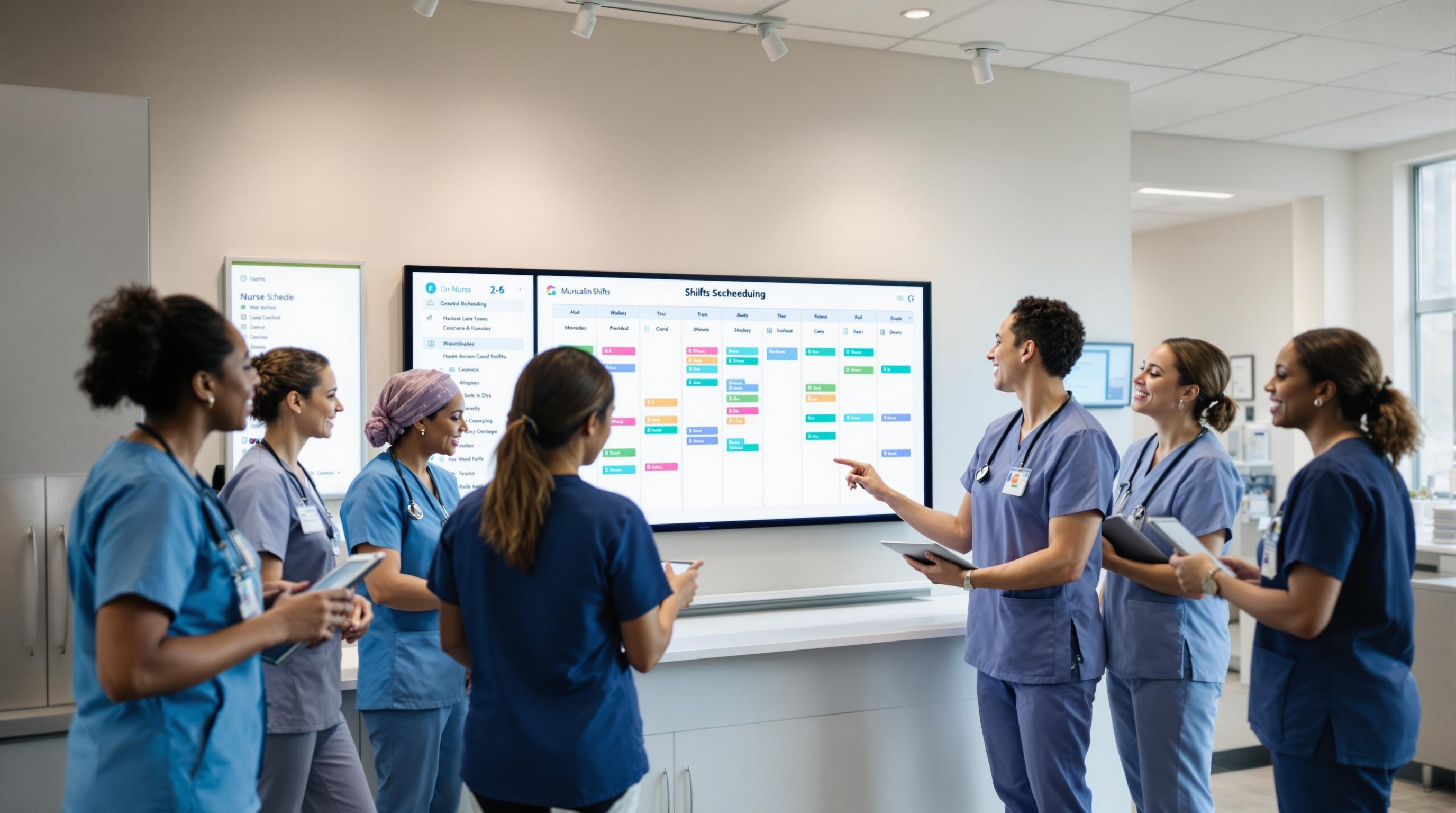Nurse Preference Based Scheduling: Boosting Satisfaction in SNFs
Discover how nurse preference based scheduling in skilled nursing facilities improves staff satisfaction, retention, and care quality. Learn more now!
Quick Navigation
- 1. Introduction
- 2. Current Challenges in Nurse Preference Based Scheduling
- 3. How Sparkco AI Transforms Nurse Preference Based Scheduling
- 4. Measurable Benefits and ROI
- 5. Implementation Best Practices
- 6. Real-World Examples
- 7. The Future of Nurse Preference Based Scheduling
- 8. Conclusion & Call to Action
1. Introduction
Did you know that over 80% of skilled nursing facilities are grappling with persistent staffing shortages as we head into 2025? According to recent industry insights, workforce challenges continue to top the list of concerns for skilled nursing leaders, often leading to burnout, increased turnover, and compromised patient care. In this high-pressure environment, the way shifts are scheduled can make all the difference—not just for operational efficiency, but for nurse satisfaction and retention as well.
Traditional scheduling methods often leave nurses feeling powerless, resulting in rigid routines, lack of transparency, and diminished work-life balance. As a result, many facilities experience a revolving door of staff, which only exacerbates existing shortages. Yet, forward-thinking organizations are starting to recognize that incorporating nurse preference into scheduling can be a game changer. Recent research highlights that flexibility, autonomy, and fairness in scheduling are directly tied to job satisfaction and staff retention—critical metrics for success in today’s skilled nursing landscape.
In this article, we’ll explore how nurse preference-based scheduling is emerging as a vital strategy to address workforce challenges in skilled nursing facilities. You’ll discover the problems with traditional scheduling, the benefits of preference-driven approaches, and the innovative technologies—like centralized scheduling and machine learning—that are making these solutions possible. Ready to learn how empowering your nursing staff with greater control over their schedules could revolutionize your facility? Let’s dive in.
2. Current Challenges in Nurse Preference Based Scheduling
Nurse preference-based scheduling, which accommodates nurses' desired shifts and work-life balance, is increasingly adopted in healthcare. While this model aims to boost job satisfaction and retention, it presents unique operational and compliance challenges. Below are key pain points currently faced by healthcare facilities leveraging this approach.
-
1. Scheduling Complexity and Time Consumption
Accommodating individual preferences makes schedule creation highly complex and time-consuming. According to a 2022 study published by the National Institutes of Health, nurse managers spend up to 20% of their administrative time managing and adjusting schedules to fit both patient needs and staff preferences. This diverts resources away from direct patient care and other strategic initiatives. -
2. Staffing Imbalances and Coverage Gaps
Allowing nurses to choose preferred shifts can lead to overstaffing during popular times (e.g., day shifts) and critical shortages during less desirable ones (e.g., nights, weekends). A systematic review in 2021 found that 64% of hospitals reported frequent understaffing on night shifts, directly linked to preference-based scheduling models. -
3. Compliance Risks and Overtime Costs
Balancing nurse preferences with federal and state labor laws is challenging. Facilities may inadvertently schedule overtime, breaching hour limits or union agreements, which can result in legal penalties. The American Hospital Association notes that U.S. hospitals spent over $24 billion on contract labor and overtime in 2021, much of it due to scheduling inefficiencies. -
4. Equity and Staff Morale Concerns
When preferences can't be evenly honored, staff may perceive favoritism, leading to decreased morale and increased turnover. Research in the Journal of Nursing Management highlights that perceived unfairness in scheduling is a top driver of nurse dissatisfaction. -
5. Negative Impact on Patient Care Continuity
Frequent schedule changes to accommodate preferences can disrupt continuity of care. Shifting teams and inconsistent nurse-patient assignments have been associated with increased medical errors and reduced patient satisfaction, as evidenced by a 2020 study in BMC Nursing. -
6. Difficulty in Meeting Fluctuating Patient Acuity
Preference-driven scheduling often overlooks patient acuity and census changes. Facilities may find themselves without adequately skilled staff during surges or emergencies, risking compliance with staffing ratio regulations and patient safety standards. -
7. Technology Limitations
Many legacy scheduling systems lack the sophistication to balance complex variables such as staff preferences, skill mixes, compliance requirements, and real-time patient needs. This forces manual adjustments, increasing administrative burden and risk of error.
In summary, while nurse preference-based scheduling can enhance staff satisfaction, its operational, compliance, and patient care challenges are significant. Addressing these pain points requires advanced scheduling solutions, robust policies, and ongoing communication to ensure optimal outcomes for both staff and patients.
3. How Sparkco AI Transforms Nurse Preference Based Scheduling
Nurse scheduling is a complex, high-stakes task that significantly impacts job satisfaction, retention, and care quality within skilled nursing facilities. Recent research from NYU Rory Meyers College of Nursing highlights that flexibility, transparency, equity, and autonomy are critical to optimal scheduling practices. Yet, traditional scheduling methods often struggle to balance these factors with organizational needs. Sparkco AI revolutionizes this process by leveraging advanced artificial intelligence and automation to address the inherent challenges of nurse preference-based scheduling.
-
1. Intelligent Preference Matching
Sparkco AI collects nurse shift preferences through an intuitive interface, enabling staff to specify desired shifts, days off, and recurring patterns. The platform’s AI engine uses these inputs to generate schedules that honor individual preferences while ensuring adequate coverage. By automating preference analysis, Sparkco AI reduces manual guesswork and increases staff satisfaction. -
2. Automated Fairness and Equity Checks
Ensuring equitable distribution of shifts is essential to workplace morale. Sparkco AI continuously monitors scheduling patterns to prevent favoritism and overburdening. Its algorithms detect and balance factors such as overtime, weekend assignments, and rotation fairness, ensuring every nurse receives equitable opportunities and obligations. -
3. Real-Time Flexibility and Self-Scheduling
Sparkco AI empowers nurses with real-time self-scheduling tools. Staff can swap shifts, request changes, or update availability directly within the platform. The AI instantly evaluates the impact of these changes on overall coverage and compliance, suggesting alternatives or approving requests seamlessly to maintain operational stability without delay. -
4. Transparent and Collaborative Scheduling
Transparency is crucial for trust and autonomy. Sparkco AI offers a shared, always-updated schedule view accessible from any device. This eliminates confusion, reduces conflicts, and fosters a collaborative environment where staff can see how their preferences and shift swaps affect the broader team. -
5. Integration with Existing Systems
Sparkco AI seamlessly integrates with leading HR, payroll, and time-tracking software, allowing facilities to streamline workflows without disrupting established processes. Real-time data synchronization ensures that schedules are always current, and compliance with organizational policies is automatically enforced. -
6. Data-Driven Insights and Continuous Improvement
Beyond scheduling, Sparkco AI provides actionable analytics on shift patterns, staffing gaps, and preference fulfillment rates. Leaders can leverage these insights to fine-tune scheduling policies, enhance staff engagement, and proactively address emerging challenges.
By automating the most time-consuming aspects of nurse scheduling and intelligently prioritizing staff preferences, Sparkco AI delivers fairer, more flexible, and transparent shift management. Its integration capabilities ensure smooth adoption, while real-time automation minimizes administrative burden—allowing nursing leaders to focus on what matters most: delivering quality care and supporting their teams.
4. Measurable Benefits and ROI
Automated nurse preference-based scheduling systems have revolutionized staffing management in skilled nursing facilities (SNFs) and hospitals. By leveraging advanced algorithms and real-time data, these platforms match shift assignments with individual nurse preferences, resulting in tangible operational and financial gains. Below are the key measurable benefits supported by data and case studies:
- Time Savings in Scheduling: Automated scheduling reduces manual scheduling time by up to 80%. According to a Becker’s Hospital Review report, nurse managers at Adventist Health saved over 20 hours per month on scheduling tasks after implementation.
- Cost Reduction: By minimizing overtime and agency reliance, nurse preference-based scheduling can cut labor costs by 3–5%. A case study at Avera McKennan Hospital reported an annual savings of $140,000 in overtime expenses post-automation.
- Lower Staff Turnover: Facilities using automated, preference-driven scheduling see nurse turnover rates drop by up to 15%. A NurseGrid case study found that turnover decreased from 24% to 19% within a year of implementation, attributing this to improved work-life balance and job satisfaction.
- Compliance Improvements: Automated systems ensure adherence to labor regulations and union rules, reducing compliance violations by 90% or more. Shiftboard reports that its clients have nearly eliminated scheduling-related compliance issues, protecting facilities from costly fines and grievances.
- Increased Shift Fill Rates: By aligning schedules with nurse preferences, shift fill rates improve by 10–20%. According to Synergy Healthcare Solutions, facilities saw their fill rates rise from 85% to over 95% after adopting automated preference-based scheduling.
- Reduced Absenteeism: Facilities report a 25–30% reduction in unscheduled absences due to increased engagement and satisfaction when nurses' scheduling preferences are accommodated (Oracle Health/LifeBridge Health Case Study).
- Improved Employee Satisfaction: According to a 2023 AMN Healthcare survey, 73% of nurses felt “significantly more satisfied” with their work schedules after automation, leading to better patient care and reduced burnout.
- Faster Response to Staffing Needs: Automated scheduling tools enable real-time adjustments, reducing shift vacancy response time from hours to minutes (Qualtrics Healthcare Scheduling Report).
Overall, automated nurse preference-based scheduling delivers a compelling ROI for skilled nursing facilities by streamlining operations, cutting costs, improving compliance, and enhancing both nurse and patient satisfaction. These measurable benefits make it an essential investment for organizations aiming to optimize workforce management and quality of care.
5. Implementation Best Practices
Successfully adopting a nurse preference-based scheduling model can enhance staff satisfaction, reduce turnover, and improve patient care outcomes in skilled nursing facilities. To ensure a smooth transition and optimal results, follow these actionable steps:
-
Assess Current Scheduling Processes
Begin by evaluating your existing scheduling workflows and identifying pain points. Gather feedback from nursing staff and supervisors about current challenges and what improvements they desire.
Tip: Use anonymous surveys or focus groups to encourage honest input.
Pitfall to avoid: Overlooking frontline staff opinions or relying solely on management perspectives. -
Engage Stakeholders Early
Involve nurses, scheduling coordinators, and leadership from the start. Clearly communicate the goals and anticipated benefits of preference-based scheduling.
Tip: Establish a multidisciplinary implementation team to foster buy-in.
Pitfall to avoid: Rolling out changes without staff involvement, leading to resistance. -
Select the Right Scheduling Technology
Choose a user-friendly scheduling platform that supports nurse preference input, offers real-time visibility, and integrates with your existing systems.
Tip: Pilot test the software with a small group before a full rollout.
Pitfall to avoid: Selecting technology based on cost alone without considering usability. -
Define Clear Policies and Parameters
Set transparent guidelines for how preferences are submitted, prioritized, and balanced with facility needs and compliance requirements.
Tip: Develop FAQ documents and training materials to clarify expectations.
Pitfall to avoid: Allowing ambiguity, which can lead to perceptions of favoritism or unfairness. -
Provide Comprehensive Training
Offer hands-on training sessions for all staff on using the new system and understanding the process.
Tip: Include both in-person and digital training options to accommodate different learning styles.
Pitfall to avoid: Assuming brief overviews are sufficient for adoption. -
Monitor and Adjust Schedules Regularly
Continuously review scheduling outcomes to ensure fairness, adequate coverage, and compliance with labor regulations.
Tip: Schedule bi-weekly check-ins for the first few months to address issues promptly.
Pitfall to avoid: Failing to adapt the process in response to feedback or operational needs. -
Communicate Transparently and Celebrate Successes
Provide regular updates about improvements, address concerns openly, and recognize staff contributions to scheduling successes.
Tip: Share metrics like increased shift satisfaction or reduced overtime in staff meetings.
Pitfall to avoid: Neglecting to highlight positive outcomes or address challenges directly. -
Plan for Ongoing Change Management
Recognize that preference-based scheduling is a cultural shift. Encourage feedback, provide support, and be prepared to refine processes as your team adapts.
Tip: Appoint “change champions” among the nursing staff to mentor and motivate peers.
Pitfall to avoid: Treating implementation as a one-time event rather than an ongoing evolution.
By following these best practices, skilled nursing facilities can foster a more engaged nursing workforce while maintaining the high standards of care required for regulatory compliance and quality outcomes.
6. Real-World Examples
Real-World Examples: Nurse Preference










